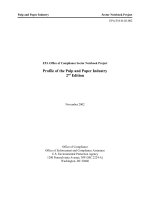OReilly programming jakarta struts 2nd edition
Bạn đang xem bản rút gọn của tài liệu. Xem và tải ngay bản đầy đủ của tài liệu tại đây (5.21 MB, 999 trang )
•
•
•
•
•
•
TableofContents
Index
Reviews
ReaderReviews
Errata
Academic
ProgrammingJakartaStruts,2ndEdition
ByChuckCavaness
Publisher :O'Reilly
PubDate :June2004
ISBN :0-596-00651-9
Pages :470
IfyouwanttousetheStrutsFrameworkto
itsfullestpotential,thisisthebookforyou.
ProgrammingJakartaStruts,2ndEdition
coverseverythingthesuccessfulearlier
editiondidaswellasplentymore:nowfully
uptodatewithStruts1.1,thiseditioncovers
thelatestmaterialontaglibrariesandthe
newJavaServerFaces(JSF)APIsandeven
includesall-newchaptersonJSF,JSTL/EL,
andsecurity.
•
•
•
•
•
•
TableofContents
Index
Reviews
ReaderReviews
Errata
Academic
ProgrammingJakartaStruts,2ndEdition
ByChuckCavaness
Publisher :O'Reilly
PubDate :June2004
ISBN :0-596-00651-9
Pages :470
Copyright
Preface
Organization
ConventionsUsedinThisBook
UsingCodeExamples
CommentsandQuestions
Acknowledgments
Chapter1.Introduction
Section1.1.ABriefHistoryoftheWeb
Section1.2.WhatAreJavaServlets?
Section1.4.JSPModel1andModel2Architectures
Section1.6.WhatIsaFramework?
Section1.3.JavaServerPages
Section1.5.WhyIsModel-View-ControllerSoImportant?
Section1.7.AlternativestoStruts
Chapter2.InsidetheWebTier
Section2.1.AnArchitectureOverview
Section2.2.TheHTTPRequest/ResponsePhase
Section2.3.StrutsandScope
Section2.4.UsingURLParameters
Section2.5.ForwardVersusRedirect
Chapter3.OverviewoftheStrutsFramework
Section3.1.ABankingAccountExample
Section3.2.LookingattheBigPicture
Section3.4.StrutsModelComponents
Section3.6.MultipleApplicationSupport
Section3.3.StrutsControllerComponents
Section3.5.StrutsViewComponents
Section3.7.Summary
Chapter4.ConfiguringStrutsApplications
Section4.1.TheStorefrontApplication
Section4.2.WhatIsaWebApplication?
Section4.3.TheWebApplicationDirectoryStructure
Section4.5.Configuringtheweb.xmlFileforStruts
Section4.7.TheDigesterComponent
Section4.4.TheWebApplicationDeploymentDescriptor
Section4.6.TheStrutsConfigurationFile
Section4.8.TheStrutsConsoleTool
Section4.9.ReloadingtheConfigurationFiles
Chapter5.StrutsControllerComponents
Section5.1.TheControllerMechanism
Section5.2.TheUtilitiesClasses
Chapter6.StrutsModelComponents
Section6.1.The"M"inMVC
Section6.2.WhatIsaBusinessObject?
Section6.3.Persistence
Section6.4.WhatDoesStrutsOfferfortheModel?
Chapter7.StrutsViewComponents
Section7.1.WhatIsaView?
Section7.2.WhatAreActionForms?
Section7.4.PerformingPresentationValidation
Section7.6.LookingAheadtoJavaServerFaces
Section7.3.UsingActionErrors
Section7.5.UsingtheDynaActionFormClass
Chapter8.JSPCustomTagLibraries
Section8.1.CustomTagsOverview
Section8.2.TagLibrariesIncludedwithStruts
Section8.3.UsingJavaBeanswithStrutsTags
Section8.5.LogicTags
Section8.7.NestedTags
Section8.4.StrutsHTMLTags
Section8.6.BeanTags
Section8.8.OtherUsefulTagLibraries
Section8.9.TheJSPStandardTagLibrary(JSTL)
Chapter9.ExtendingtheStrutsFramework
Section9.1.WhatAreExtensionPoints?
Section9.2.GeneralExtensionPoints
Section9.4.ExtendingViewComponents
Section9.3.ControllerExtensionPoints
Section9.5.DownsidestoExtendingtheFramework
Chapter10.ExceptionHandling
Section10.1.JavaExceptionHandling
Section10.2.PerformanceImpactofExceptionHandling
Section10.3.SystemVersusApplicationExceptions
Section10.5.ExceptionHandlingProvidedbyStruts
Section10.4.UsingChainedExceptions
Section10.6.TyingUptheLooseEnds
Section10.7.Conclusion
Chapter11.TheValidatorFramework
Section11.1.TheNeedforaValidationFramework
Section11.2.InstallingandConfiguringtheValidator
Section11.4.CreatingYourOwnValidationRules
Section11.6.InternationalizingtheValidation
Section11.3.UsinganActionFormwiththeValidator
Section11.5.TheValidatorandJSPCustomTags
Section11.7.UsingtheValidatorOutsideofStruts
Chapter12.InternationalizationandStruts
Section12.1.WhatIsInternationalization?
Section12.2.SupportforI18NinJava
Section12.3.InternationalizingYourStrutsApplications
Section12.4.ExceptionHandlingandInternationalization
Chapter13.StrutsandEnterpriseJavaBeans
Section13.1.ImplementingtheStorefrontServiceUsingEJB
Section13.2.InterfacingStrutstoEJB
Section13.3.Conclusion
Chapter14.UsingTiles
Section14.1.UnderstandingTemplates
Section14.2.InstallingandConfiguringTiles
Section14.4.TheTilesTagLibrary
Section14.3.UsingTiles
Section14.5.UsingDefinitions
Section14.6.InternationalizationSupportwithTiles
Chapter15.LogginginaStrutsApplication
Section15.1.LogginginaWebApplication
Section15.2.UsingtheServletContainerforLogging
Section15.4.Usingthelog4jPackage
Section15.6.ThePerformanceImpactoflog4j
Section15.3.JakartaCommonsLogging
Section15.5.UsingCommonsLogginginJSPPages
Section15.7.Third-Partylog4jExtensions
Section15.8.Java1.4LoggingAPI
Chapter16.PackagingYourStrutsApplication
Section16.1.ToPackageorNottoPackage
Section16.2.PackagingtheApplicationasaWARFile
Section16.4.CreatinganAutomatedBuildEnvironment
Section16.3.BuildingYourStrutsApplicationswithAnt
Section16.5.RestartingYourServerRemotely
Chapter17.AddressingPerformance
Section17.1.WhatIsGoodPerformance?
Section17.2.PerformanceVersusLoadTesting
Section17.3.Performance-andStress-TestingTools
Section17.4.TestingtheStorefrontApplication
Section17.5.PerformanceandScalabilityGotchas
Chapter18.JavaServerFaces
Section18.1.StrutsandJavaServerFaces
Section18.2.OverviewofJSFArchitecture
Section18.4.ConvertingExistingStrutsApplicationstoJSF
Section18.3.InstallingandRunningtheExampleStruts-FacesApplication
Section18.5.FurtherReading
AppendixA.ChangesSinceStruts1.0
SectionA.1.ActionServletandRequestProcessor
SectionA.2.ModificationstotheStrutsActionClass
SectionA.3.Changestoweb.xmlandstruts-config.xml
SectionA.4.ActionStaticsChanged
SectionA.6.NewFeaturesofStruts1.1
SectionA.8.ChangetoCommonsLogging
SectionA.10.DeprecationoftheGenericDataSource
SectionA.5.TagUtilsandModuleUtils
SectionA.7.TheStrutsValidator
SectionA.9.RemovalofAdminActions
SectionA.11.DependencyonCommonsProjects
AppendixB.DownloadingandInstallingStruts
SectionB.1.TheBinaryVersusSourceDistributions
SectionB.2.TipsonInstallingStrutsinTomcat
SectionB.3.TipsonInstallingStrutsinWebLogic
SectionB.4.TipsonInstallingStrutsinWebSphere
AppendixC.Resources
SectionC.1.TheStrutsMailingLists
SectionC.2.TheStrutsResourceWebPage
SectionC.3.TilesSite
SectionC.5.TheStrutsConsole
SectionC.4.NestedTagsSite
SectionC.6.EasyStrutsProject
Colophon
Index
Copyright©2004O'ReillyMedia,Inc.
PrintedintheUnitedStatesofAmerica.
PublishedbyO'ReillyMedia,Inc.,1005GravensteinHighway
North,Sebastopol,CA95472.
O'Reillybooksmaybepurchasedforeducational,business,or
salespromotionaluse.Onlineeditionsarealsoavailablefor
mosttitles().Formoreinformation,
contactourcorporate/institutionalsalesdepartment:(800)
998-9938or
NutshellHandbook,theNutshellHandbooklogo,andthe
O'ReillylogoareregisteredtrademarksofO'ReillyMedia,Inc.
TheJavaSeries,ProgrammingJakartaStruts,theimageofa
percheron,andrelatedtradedressaretrademarksofO'Reilly
Media,Inc.
Java™andallJava-basedtrademarksandlogosaretrademarks
orregisteredtrademarksofSunMicrosystems,Inc.,inthe
UnitedStatesandothercountries.Manyofthedesignations
usedbymanufacturersandsellerstodistinguishtheirproducts
areclaimedastrademarks.Wherethosedesignationsappearin
thisbook,andO'ReillyMedia,Inc.wasawareofatrademark
claim,thedesignationshavebeenprintedincapsorinitialcaps.
Whileeveryprecautionhasbeentakeninthepreparationofthis
book,thepublisherandauthorsassumenoresponsibilityfor
errorsoromissions,orfordamagesresultingfromtheuseof
theinformationcontainedherein.
Preface
Overthelastfewyears,webdevelopmenthasturnedavery
importantcorner.GonearethedayswhenJava™developers
wrestledwithasingleJSPthatcontainedpresentationlogic,
databaseaccessviaSQL,andnavigationalintelligence.Java
webdevelopershavelearnedfromtheirmistakes,paidtheprice
indebuggingandmaintenancetime,andmovedon.
Thenumberandvarietyofreadilyavailablewebframeworks
todayisimmense.It'shardtopointabrowserataJava
technicalsitewithoutfindinganewlyreleasedwebframework
that'sgoingtorevolutionizethemodernworld.Whilesomemay
seethisasabadthingthatmightdividetheJavacommunity,
thetruthisthattheconstantemergenceofnewframeworksis
justevolutionatwork.
Thedesignandconstructionoftoday'snontrivialweb
applicationspushesdeveloperstothelimitofwhat'slogically
andphysicallypossible.Myriadsolutionsarethrownatthe
problemstheseapplicationspresent.Someofthesolutions
stick,andaswithhumanevolution,valuablecharacteristicsare
passedoninfuturegenerationsofsoftware.Othersolutionsdo
notthosethatfailtoservetheneedsofusersandaddvalue
usuallyfallbythewayside.
Throughthisevolutionaryprocess,theJakartaStruts
framework(createdbyCraigR.McClanahananddonatedtothe
ApacheSoftwareFoundationin2000)hasemergedasoneof
thebestwebframeworksavailable.ThisbookcoversVersion
1.1,whichcontainsmanymajorenhancementsoverthe
previousJakartaStrutsrelease.Ifyouarebuildingapplications,
web-basedornot,oneofthemainthingsyouwilllearnfrom
thisbookisthatframeworkssuchasStrutsareagreattime
investment.
Organization
Thisbookbeginswithapreliminarydiscussionthatlaysthe
groundworkfortherestofthematerial.Thisdiscussionwillbe
arefresherforsomeandcompletelynewforothers.From
there,weexplorethecomponentsofStruts'sMVC
implementation,includingalookattheJSPcustomtagsthat
arepartoftheframework.Then,toroundoutyour
understandingofthevalueoftheStrutsframework,welookat
severalcomplicatedbutimportanttopicsrelatedtobuilding
web-basedapplications.
Chapter1,Introduction
Thischapterdiscussessomepreliminaryconcepts,suchas
theMVCpattern,Model2,andtheideaofasoftware
framework.Althoughmanydevelopersmayalreadybe
familiarwithsomeoralloftheideaspresentedhere,Iwant
toensurethatallreadersarestartingfromthesameplace.
Theconceptspresentedinthischapterhelptolaythe
foundationfortherestofthebook.
Chapter2,InsidetheWebTier
TheStrutsframeworkisbasedontheJavaServlet
technologyand,toalesserextent,JavaServerPages,and
thereforeistightlycoupledtoawebcontainer.ForStruts
developers,understandinghowthewebcontainerprocesses
clientrequestsisfundamentaltounderstandingthe
frameworkitself.Thischapterdiscussesthecomponentsof
thewebcontainerandtheresponsibilitiesofeach.
Chapter3,OverviewoftheStrutsFramework
ThischapterprovidesanoverviewoftheStrutsframework;
itdoesnotattempttocoverallofthefeaturesorgointo
significantdepth.Itemphasizeshowallthepiecesfitinto
theMVCandModel2architecturepresentedinChapter1.
Chapter4,ConfiguringStrutsApplications
TheStrutsframeworkusestwoseparatebutsomewhat
relatedtypesofconfigurationfiles,whichmustbe
configuredproperlybeforeanapplicationwillfunction
properly.DuetothepopularityandflexibilityofXML,both
typesofconfigurationfilesarebasedonXML.Thischapter
presentsthesyntaxofthefiles.
Chapter5,StrutsControllerComponents
TheStrutsframeworkusesaservlettoprocessincoming
requests;however,itreliesonmanyothercomponentsthat
arepartofthecontrollerdomaintohelpitcarryoutits
responsibilities.Thischaptertakesin-depthlookatthe
componentsthatareresponsibleforthecontroller
functionalityintheframework.
Chapter6,StrutsModelComponents
Thischapterintroducesthecomponentsthatmakeupthe
modelportionofaStrutsapplication.Themodelrepresents
thebusinessdataforanapplicationandshouldclosely
resemblethereal-worldentitiesandbusinessprocessesfor
theorganization.Thischapterexplorestherolesand
responsibilitiesofthemodelcomponentswithintheStruts
frameworkandfocusesonbuildinganarchitecturallycorrect
implementationfortheStorefrontapplication.Special
attentionisgiventousingapersistenceframeworkthatcan
beintegratedintoaStrutsapplicationeasilyand
effortlessly.
Chapter7,StrutsViewComponents
Thischapterintroducesthecomponentsthatmakeupthe
viewportionoftheStrutsframework.Theframeworkuses
theviewcomponentstorenderdynamiccontentforthe
client.BasedprimarilyonJavaServerPages,the
componentsprovidesupportforinternationalized
applicationsaswellasforuser-inputacceptance,validation,
anderrorhandling,allofwhichmakeiteasierforthe
developertofocusonbusinessrequirements.Thischapter
concludesthethree-partdiscussionofhowtheStruts
frameworkimplementstheMVCpattern.
Chapter8,JSPCustomTagLibraries
Thischapterlooksatthedifferentcategoriesoftagsand
howtheycanhelpmakedevelopingapplicationswiththe
Strutsframeworkeveneasier.Itisnotmeanttobean
exhaustivereferenceforeverytagthat'spartoftheStruts
taglibrariesthatinformationcanbefoundwithintheStruts
userguideorJavaDocs.Therealpurposeofthischapteris
toputforththebenefitsofusingtheStrutstaglibrariesand
toprovideafewstrategiesthatcanhelpmaketheswitchto
usingthetagslesspainful.
Chapter9,ExtendingtheStrutsFramework
Oneofthebiggestadvantagesofusingaframeworkisthe
abilitytoextendandcustomizeitbasedontheneedsofthe
application.TheStrutsframeworkisnoexception;it
providesseveralimportantextensionpointsfordevelopers.
Thischaptertakesaquickglanceatseveralofthose
extensionpointsandexaminesthebenefitsanddrawbacks
ofextendingtheframework.
Chapter10,ExceptionHandling
ThischapterlooksathowtousetheJavaexceptionhandlingmechanismwithinyourStrutsapplicationstomake
themmorerobustandallowthemtorespondgracefully
whenthingsdon'tgoasexpected.Specialattentionisgiven
tothedifferencesbetweenperformingtheexception
handlingprogrammaticallyandusingthenewdeclarative
featureaddedtotheStrutsframeworkinVersion1.1.
Chapter11,TheValidatorFramework
ThischapterintroducestheValidatorframework,whichwas
createdspecificallytoworkwithStrutscomponents.The
Validatorallowsyoutodeclarativelyconfigurevalidation
routinesforaStrutsapplicationwithouthavingtoprogram
specialvalidationlogic.
Chapter12,InternationalizationandStruts
ThischapterfocusesonwhatittakestomakeaStruts
applicationavailabletocustomersfromaroundtheworld,
regardlessoftheirlanguageorgeographicallocation.Asis
oftenthecaseinsoftwaredevelopment,planningaheadis
themostimportantthingthatyoucandotohelpensure
success.Afterreadingthischapter,youshouldbeableto
buildStrutsapplicationsthatcansupportabroadrangeof
customers.
Chapter13,StrutsandEnterpriseJavaBeans
Thischaptercoverstheissuesyouneedtoconsiderwhen
developinganinterfacebetweenyourStrutsactionsandan
applicationtier.Itfocusesoninterfacingtoamodelbuilt
usingEnterpriseJavaBeans™(EJB).
Chapter14,UsingTiles
ThischapterlooksattheTilesframework,whichnowispart
ofthecoreStrutsdistribution.TheTilesframeworkisan
advancedtemplatingframeworkthatreducestheamountof
redundantcodeawebapplicationcontainsandallows
developerstobetterseparatecontentfromlayout.
Chapter15,LogginginaStrutsApplication
ThischapterexamineshowtheuseoflogginginyourStruts
applicationscanhelpyouidentifydefectsbeforethe
applicationsgetintoproductionand,ifyoursoftware
alreadyisbeingusedinproduction,howloggingcanhelp
youidentifyproblemsandarriveatsolutionsmuchmore
quickly.
Chapter16,PackagingYourStrutsApplication
Thischapterdiscussesthebestpracticesforpackagingand
deployingaStrutsapplicationandwhatittakesto
automatethebuildprocessforyourenvironment.Special
coverageisgiventoAnt,theJava-basedbuildtoolavailable
fromJakarta.
Chapter17,AddressingPerformance
Thischapterexplorestheperformanceimplicationsofusing
theStrutsframeworkanditsassociatedtechnologiesto
buildwebapplicationsanddiscusseshowcertaindesignand
programmingdecisionsaffecttheoverallperformanceofthe
applications.Itcoversperformance,load,andstress
testing,andthestepsnecessarytocarryouteach.
Chapter18,JavaServerFaces
ThischapterprovidesanoverviewofyetanotherJava
technologybeingbirthedfromtheJavaCommunity.
JavaServerFacesprovidessomepromisingcontinuationfor
theJavawebdevelopmentcommunity.Althoughsome
overlapexistsbetweenStrutsandJSF,thereisplentyof
roomforbothandthischapterexploreswhatthat
integrationlookslike.
AppendixA,ChangesSinceStruts1.0
Thisappendixenumeratesthenewfeatureswithinthe1.1
release.
AppendixB,DownloadingandInstallingStruts
Thisappendixdiscussesthestepsfordownloadingand
installingStrutsinyourenvironment.
AppendixC,Resources
Thisappendixlistsseveralresourcesthatcanhelpincrease
yourknowledgeonceyou'vemasteredtheconceptsinthis
book.
ConventionsUsedinThisBook
Thefollowingfontconventionsareusedinthisbook:
Italicisusedfor:
Unixpathnames,filenames,andprogramnames
Internetaddresses,suchasdomainnamesandURLs
Newtermswheretheyaredefined
Boldfaceisusedfor:
NamesofGUIitems(windownames,buttons,menu
choices,etc.)
Constantwidthisusedfor:
Commandlinesandoptionsthatshouldbetypedverbatim
NamesandkeywordsinJavaprograms,includingmethod
names,variablenames,andclassnames
XMLelementnamesandtags,attributenames,andother
XMLconstructsthatappearastheywouldwithinanXML
document
Indicatesatip,suggestion,orgeneralnote.
Indicatesawarningorcaution.
UsingCodeExamples
Thisbookisheretohelpyougetyourjobdone.Ingeneral,you
mayusethecodeinthisbookinyourprogramsand
documentation.Youdonotneedtocontactusforpermission
unlessyou'rereproducingasignificantportionofthecode.For
example,writingaprogramthatusesseveralchunksofcode
fromthisbookdoesnotrequirepermission.Sellingor
distributingaCD-ROMofexamplesfromO'Reillybooksdoes
requirepermission.Answeringaquestionbycitingthisbook
andquotingexamplecodedoesnotrequirepermission.
Incorporatingasignificantamountofexamplecodefromthis
bookintoyourproduct'sdocumentationdoesrequire
permission.
Weappreciate,butdonotrequire,attribution.Anattribution
usuallyincludesthetitle,author,publisher,andISBN.For
example:"ProgrammingJakartaStruts,SecondEdition,by
ChuckCavaness.Copyright2004O'ReillyMedia,Inc.,0-59600651-9."
Ifyoufeelyouruseofcodeexamplesfallsoutsidefairuseor
thepermissiongivenabove,feelfreetocontactusat
CommentsandQuestions
Pleaseaddresscommentsandquestionsconcerningthisbookto
thepublisher:
O'ReillyMedia,Inc.
1005GravensteinHighwayNorth
Sebastopol,CA95472
800-998-9938(intheU.S.orCanada)
707-829-0515(internationalorlocal)
707-829-0104(fax)
Thereisawebpageforthisbook,whichlistserrata,examples,
andadditionalinformation.Youcanaccessthispageat:
/>Tocommentorasktechnicalquestionsaboutthisbook,send
emailto:
Formoreinformationaboutbooks,conferences,Resource
Centers,andtheO'ReillyNetwork,seetheO'Reillywebsiteat:
Acknowledgments
Writingabookofthistypeisnevertheworkofjustoneperson;
itliterallytakesanarmyofhardenedsoldiers,andthisbookis
noexception.Fromtheeditorstothemarketingorganizationto
thereviewersofthemanuscript,thisbooksimplywouldnot
havebeenpossiblewithoutthegroupofdedicatedfolksthat
gaveupmanyoftheirnightsandweekendstohelpensurethat
thequalitywasthehighestpossible.Anycreditshouldbegiven
toallofthegreatpeopleinvolved;anymistakesaremine
alone.
First,IneedtothankmyO'Reillyeditors,BrettMcLaughlinand
RobertEckstein,twoofthemostdedicatedandsincereeditors
thatIhaveworkedwith.Ihopewehaveachancetowork
togetheronfutureprojects.Youradviceandleadershipmade
thetaskmucheasierthanIcouldhaveimagined.Ialsowould
liketothankKyleHartfromO'Reilly'smarketingdepartment.
Yourhelpwasdearlyappreciated.
Next,Iwouldliketoacknowledgetheteamoffinedevelopers
thatIfirstlearnedStrutswith.ThebondthatourlittleNVteam
hadwassomethingspecialthatcomesaroundonlyonceina
while.Ireallyenjoyedworkingwithallofyou.
Thefollowingpeopleplayedaspecialrolebygivingmeadvice
onthebook'scontentanddirection:SteveArdis,JillEntinger,
SeeYamLim,andTedHusted(althoughTedmaynotrealize
thathecontributedinthisway).
WhenIfirstdecidedtopostthedraftchaptersofthebook,I
madeacommentthatifanyreviewerswentbeyondthecallof
duty,Iwouldpersonallythankthemintheacknowledgmentsof
thebook.LittledidIrealizehowmanywouldtakemeuponit!
TherearesomanythatIcan'tthankeachandeveryone
individually.Over100peoplecontributedfeedbackforoneor
morechaptersofthisbook.TheStrutscommunityisbyfarone
ofthebest.AlmosteverypersonontheStrutsmailinglisthas
contributedinonewayoranother.Toeachofyou,thankyou!
Thankstothefollowingpeople:JohnGuthrie,DavidKarr,Brent
Kyle,StefanoScheda,andRickReumannforaskingalltheright
questions,MarkGalbreathforremindingmeofmy10th-grade
Englishteacher,andJamesMitchellandJamesHolmesfor
gettingmeinvolvedwiththeAtlantaStrutsgroup.
IneedtosayaspecialthankstoTimDruryforhishelpon
Chapter16.HisAntskillsareknownworldwide.Specialthanks
alsotoBrianKeeton,whowroteChapter13becauseI'mtoo
slowhe'sthesmartestEJBdeveloperIknow.Bothofyouare
greatfriendsandsimplythefinesthumansthatI'veevermet.
Justknowingyouhasmademeabetterperson.Ihopewecan
worktogetheragain.
ThegroupatTheServerSide.comdeservesspecialthanksfrom
meandthereviewersforallowingthedraftchaptersofthis
booktobeavailablefordownload.Thisisagreatexampleof
whatthefutureholdsforbookpublishing.
IwouldberemissifIdidn'tthanktheentireStrutscommunity.
Ihavemetandcorrespondedwithmanysmartdeveloperswho
alsostrikemeasjustreallyfunpeopletohangaroundwith.
ThefeedbackandsuggestionsIreceivedduringthisprocess
wereawesome.Ihopethatallofyougotsomebenefitoutof
this,andIappreciateeveryone'spatiencewhilesomeofthis
wasfiguredoutasIwent.
Finally,allStrutsdevelopersshouldgivethankstoCraig
McClanahanforhavingthewitsabouthimtocreatethe
frameworkandmakeitfreelyavailabletothecommunity.He
couldhavetriedtomakeaprofitfromitbystartingStruts,Inc.,
butherealizedthathewouldberewardedten-foldanyway,and
I'msurehehasbeen.Craig,it'saniceframework,youshould
beproud.AndtoallofthecommittersontheStrutsproject,
whatwoulditreallybewithoutyou?Thanksforallofyourhelp.
Chapter1.Introduction
TheStrutsopensourceframeworkwascreatedtomakeit
easierfordeveloperstobuildwebapplicationsbasedonthe
JavaServletandJavaServerPages(JSP)technologies.Likea
building,awebapplicationmusthaveasolidfoundationfrom
whichtherestofthestructurecangrow.TheStrutsframework
providesdeveloperswithaunifiedinfrastructureuponwhich
Internetapplicationscanbebased.UsingStrutsasthe
foundationallowsdeveloperstoconcentrateonbuildingthe
businessapplicationratherthanontheinfrastructure.
TheStrutsframeworkwascreatedbyCraigR.McClanahanand
donatedtotheApacheSoftwareFoundation(ASF)in2000.The
projectnowhasseveralcommittersfromaroundtheworld,and
manydevelopersarecontributingtotheoverallgoodofthe
framework.TheStrutsframeworkisoneofmanywell-known
andsuccessfulApacheJakartaprojects.OthersincludeAnt,
log4j,andTomcat.TheoverallmissionoftheJakartaprojectis
toprovidecommercial-qualityserversolutions,basedonthe
Javaplatform,inanopenandcooperativefashion.
1.1ABriefHistoryoftheWeb
Nobookonwebtechnologywouldbecompletewithoutabrief
lookathowtheWorldWideWeb(WWW)hasbecomeas
popularasitistoday.TheWebhascomealongwaysincethe
dayswhenthefirsthypertextdocumentsweresentoverthe
Internet.In1989,whenthephysicistsattheCERNlaboratory
proposedtheideaofsharingresearchinformationbetween
researchersusinghypertextdocuments,theyhadnoideahow
bigtheWebwouldgroworhowessentialitwouldbecometo
dailylifeformuchoftheindustrializedworld.TheWebisnow
anacceptedpartofourvernacular.
IttookawhileforthebenefitsofusingtheWebtobecome
cleartoothersoutsideofCERN,butasweallknow,it
eventuallyeruptedintowhatweusetoday.Fromitsbeginnings,
theWebwasdesignedfordealingwithstaticdocuments,butit
wasanaturalprogressiontowanttheabilitytogenerate
documentcontentdynamically.TheCommonGatewayInterface
(CGI)wascreatedtodothatverything.CGIisastandardthat
allowswebserverstointeractwithexternalapplicationsinsuch
awaythathypertextpagesnolongerhavetobestatic.ACGI
programcanretrieveresultsfromadatabaseandinsertthose
resultsasatableinahypertextdocument.Likewise,data
enteredintoahypertextpagecanbeinsertedintothe
database.Thistechnologyopenedupinfinitepossibilitiesand,
infact,startedtheInternetcrazeofthemid-1990sandtoday.
AlthoughCGIapplicationsareverygoodatwhattheydo,there
aresomeseriouslimitationstothisapproach.Foronething,
CGIapplicationsareveryresource-intensive.Anewoperating
system(OS)heavyweightprocessiscreatedtohandleevery
requestthatcomesfromabrowser.OncetheCGIscriptis
finishedexecuting,theprocesshastobereclaimedbytheOS.
Thisconstantstartingandstoppingofheavyweightprocessesis
terriblyinefficient.Youcanimaginehowbadtheresponsetime









